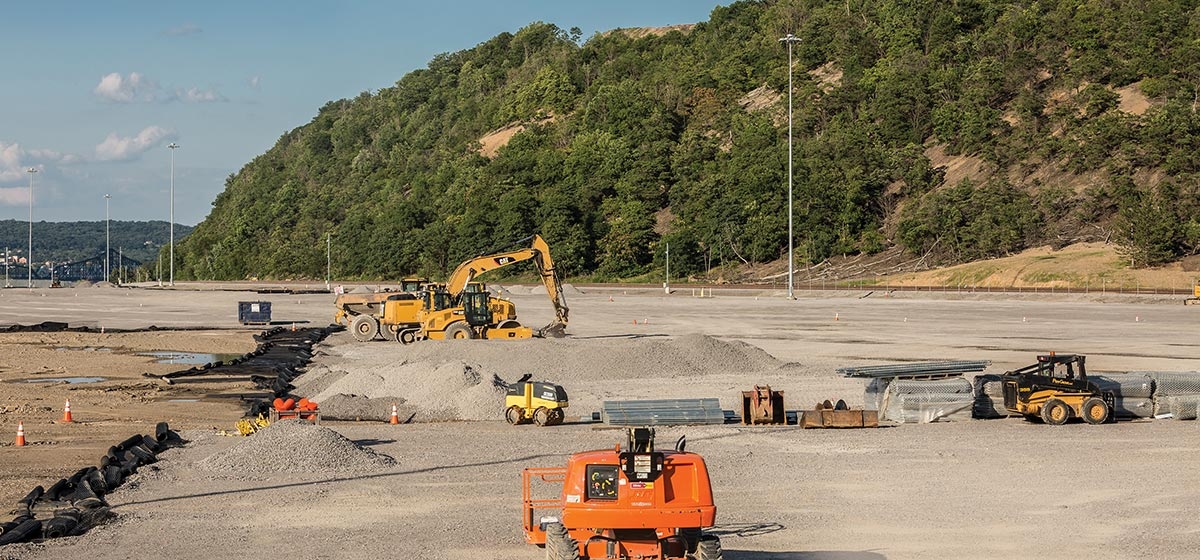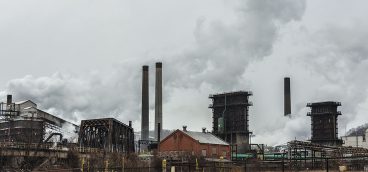
A decade ago, as Consol Energy’s 150th anniversary drew near, top executives began to take stock in where the company stood as a leading producer of coal and where that path would take it. Coal was in what CEO Nicholas DeIuliis called a “supercycle.” It was the workhorse of the national power grid and less expensive than competing fuels. U.S. production was robust, reaching a record 1.2 billion tons in 2008. Companies were expanding their reserves.
“Everything,” DeIuliis recalled, “was looking awesome.”
That was when the company decided to back out of the coal business it helped pioneer.
Regulation was a concern. Burning coal creates major air pollutants that are linked more strongly to serious health consequences with each new study published, which has led to stricter and more expensive regulations to control them. And it was not lost on the Cecil-based company that it was sitting on the Marcellus Shale formation, the nation’s largest natural gas field.
Consol’s decision to shift from coal to natural gas was fortuitously timed. Demand for natural gas soared, driven by an abundance of shale gas and lower prices. It enjoyed, albeit briefly, the image of an environmentally acceptable bridge to the time when renewable energy matures and offers a cleaner future. And its liquid byproducts have value as important feedstock for petrochemical manufacturing.
In southwestern Pennsylvania, the newest power plant to be built is fired by natural gas rather than coal.
In Beaver County, Shell is building an ethane “cracker” complex to turn natural gas liquids into polyurethane coveted by the plastics industry, raising hope among policymakers and economic development groups that it signals the budding of a major petrochemical manufacturing corridor in southwestern Pennsylvania, West Virginia and Ohio.
But the impact the transition will have on air quality is coming under greater scrutiny. Natural gas, while less sooty than coal when burned, is not without an environmental footprint. And a growing body of evidence suggests that when emissions from the well pad to industrial use are considered, the shift to natural gas could add more air toxics, greenhouse gases and other pollutants to southwestern Pennsylvania’s already overburdened air.
Energy market shifts
The fall of coal and rise of natural gas has been as swift as it has been dramatic.
Trends in the electric power industry tell the story in a glance. Power plants are coal’s biggest customer, claiming 93 percent of the coal sold in the U.S.
Coal-fired power plants, many of which are aging toward retirement, generated nearly half of the nation’s electricity in 2007. Today, they produce 30 percent and, for the first time, are being out-produced by newer power plants whose generators run on natural gas. In 2016, natural gas generated 34 percent of U.S. electricity, up from 22 percent 10 years earlier, according to U.S. Energy Information Administration data.
The shift is seen across the nation as older coal-fired power plants close and gas-fired plants step in to pick up the slack to reign as the leading source of electricity.
Last year, Tenaska, an Omaha-based energy company, broke ground on a 925-megawatt natural gas-fired power plant in Westmoreland County. And other energy companies announced plans to build natural gasfired power plants in and around the region, including a 550-megawatt plant in Elizabeth Township, Allegheny County, a 536-megawatt plant in Greene County and a 1,050-megawatt plant in Cambria County.
“We are seeing an unprecedented and rapid shutdown of coal-fired plants,” said Gregory Reed, director of the University of Pittsburgh’s Center for Energy and the Energy GRID Institute. “In my experience, I don’t think we’ve seen anything this dynamic. We’ve gone through changes before, but not changes like this in such a short amount of time.”
Drawn to natural gas
A confluence of factors is driving the rapid transition.
Scientific evidence of the health risk that industrial emissions pose has led to a steady tightening of air quality regulations for fine particulates, sulfur dioxide, nitrogen oxides and other pollutants that coal-fired plants emit in large volumes and require expensive technologies to control. At the same time, many coal-burning plants are nearing the end of their life cycle and face extensive and expensive upgrades.
Coal no longer enjoys a substantial price advantage over its chief competitor, due to the efficient harvesting of shale gas with hydraulic fracturing technology that has roiled energy markets.
Natural gas prices have fallen to levels roughly comparable to where locally delivered coal has been priced, said Edward Rubin, a professor and founding member of the Carnegie Mellon University Engineering and Public Policy department. “It’s a radically different situation than 40 or 50 years ago. Natural gas was two to three times more expensive than coal. When fracking started making natural gas more plentiful—and bringing its price down—that’s when you have this radical shift.”
Natural gas burns much more efficiently than coal and that enables plants to make more electricity to sell from every unit of fuel they buy to fire their generators. And gas-fired generators reach operating temperature more quickly than coal-fired boilers, adjust to the demands of the power grid more nimbly, and waste less energy.
Coal, as a result, is taking it on the chin.
Falling demand has accelerated the downsizing of the workforce that began decades ago with the mechanization of mining. Coal employed 143,000 workers in 2011. Five years later, 43 percent of those jobs had vanished, leaving fewer than 82,000 workers in the industry, the U.S. Mine Safety and Health Administration reports.
Companies that had been snapping up coal reserves are now abandoning them for natural gas.
Consol sold its underground West Virginia mines in 2013 and its surface mines in southern West Virginia in 2016. The company plans to sell or spin off its last coal operation, its Bailey, Enlow Fork and Harvey mines in Greene County, by the end of this year.
But coal is not the only energy industry under pressure. Following a trend seen in other states, Exelon in May announced plans to close its Three Mile Island nuclear plant near Harrisburg. Reasons include difficulties selling guaranteed power for coming years and competing with cheaper natural gas.
Meanwhile, natural gas is steadily flowing from the Marcellus Shale underneath southwestern Pennsylvania.
Production has risen consistently, even in recent years when low energy prices inflicted pain, jobs were shed and fewer wells were drilled.
Such resiliency is a sign of the shale gas industry’s maturity, said David Spigelmyer, president of the Marcellus Shale Coalition, a shale gas trade group. Early wells, for example, could take as long as 60 days to drill and might extend only one-half mile horizontally through the shale to harvest the gas trapped within it. Today, drillers can sink a well in 10-15 days and extend it 2-3 miles to reach more gas.
Over the course of a decade, the Marcellus Shale has come to produce 39 percent of the nation’s natural gas, more than any other shale play.
But shale activity in Pennsylvania has slowed. The number of wells drilled has fallen from a high of 1,956 in 2011 to 503 in 2016, state Department of Environmental Protection (DEP) data show. Jobs in the Pennsylvania’s shale gas industry, which peaked in 2014 at nearly 32,000, decreased 10 percent the following year.
And retiring coal-fired plants in favor of new plants that run on natural gas does not appear to be a job-generating proposition. Tenaska, for example, says it will operate its 925-megawatt natural gas power plant in Westmoreland County with only 25 employees. First Energy’s 2,490-megawatt coal-fired plant in Washington County generates 2.7 times more energy, but does so with 14 times the number of workers.
But luring petrochemical companies to the region with the cheap and ample supply of feedstock that shale gas offers is expected to deliver jobs and investment. The Shell ethane cracker being built in Beaver County and another in southeastern Ohio proposed by a Thailand-based company follow a vision endorsed by the governors of Pennsylvania, West Virginia and Ohio of creating a petrochemical manufacturing corridor that holds the promise of boosting local economies and, once again, posing the challenge of balancing commerce, environment and public health.
Wary of emissions
A decade ago, the Sierra Club viewed natural gas as “a bridge fuel” to a cleaner renewable energy future. It even accepted millions of dollars in donations from Chesapeake Energy, a shale gas producer, to support its campaign against using coal as fuel. The honeymoon was short-lived.
Within three years, the nation’s largest grassroots environmental organization reversed its position. It quit accepting Chesapeake’s money, opposed hydraulic fracturing and made it known it no longer considered natural gas to be a “kinder, gentler” fuel in light of rising concern among local chapters and increasing scientific evidence of the potential risks to the environment and public health.
Understanding how the shift to natural gas affects air quality is complicated by spotty data, large numbers of emission sources, wide variability in emissions among wells and other issues.
Natural gas has been shown to be cleaner than coal in some regards.
A natural gas-fired power plant generator emits 406.6 kilograms of carbon dioxide per megawatt hour—less than half of the greenhouse gas emitted from a coal-fired generator, according to the U.S. Department of Energy.
Air quality modeling estimates that the new Shell ethane cracker will emit significantly smaller volumes of major air pollutants, such as sulfur dioxide and carbon monoxide, than the coal-fired zinc plant that previously occupied the Beaver County site.
But evidence suggests that when the full cycle from drilling to industrial use is considered, the shift to natural gas as the leading fuel imposes its own burdens on air quality.
Estimated emissions from the Shell cracker also suggest it will release higher concentrations of several hazardous air pollutants than the zinc smelter that was razed to make room for it. The air toxics include volatile organic compounds (VOC), which along with nitrogen oxides are a key ingredient of ground-level ozone.
Ground-level ozone is a widespread air pollutant linked to an increased risk of health problems such as lung disease and asthma attacks. The air in southwestern Pennsylvania continues to carry ozone levels that exceed federal limits.
University of Pittsburgh toxicologist James Fabisiak found that the additional VOC emissions from the Shell ethane cracker could reverse the downward trend in levels of the air toxic that Beaver County has experienced since 1999.
Studies also report a link between shale gas drilling and increases in ozone, including one by University of Texas researchers who found that ozone levels tend to rise when higher gas prices spur greater production in the Eagle Ford shale play.
Locally, DEP data suggest that the emissions from shale gas operations have increased levels of ozone-forming nitrogen oxides and VOC in Butler, Fayette, Greene, and Washington counties, where fracking is the most concentrated in the seven-county Pittsburgh Metropolitan Statistical Area. In fact, shale industry emissions are the largest source of VOC in Butler, Fayette, and Washington counties and account for nearly half of the emissions in Greene County.
“We are seeing ozone out West in the gas fields that is being driven by VOC and one has to wonder if that could also happen here,” said Fabisiak, an associate professor of environmental and occupational health at the University of Pittsburgh.
Methane leaks from wells, pipelines and other sources is another environmental issue raised by shale gas development. Methane is a potent greenhouse gas. The U.S. Environmental Protection Agency and several studies estimate that anywhere from 1.6 percent to 4 percent or more of the methane from shale gas operations is lost to leakage.
Gas storage facilities are particularly vulnerable to leaking in Pennsylvania, where 830 sites are at least 60 years old and 45 percent of them were not designed for storage and don’t meet current standards, according to a Harvard University study.
“Natural gas is much harder to handle than coal. It has a tendency to leak,” Fabisiak said. “The leaking of methane from when it is coming out of the ground to when it is being delivered to its ultimate destination is where there is a lot of uncertainty.”
The number of health studies related to natural gas is also increasing, although a shortage of data is proving to be an obstacle in precisely determining the level of risk to which people are exposed. The majority of recent studies identify areas of concern, including one that found higher rates of low-birth-weight babies born to mothers living places where fracking is the most concentrated.
In 2013, as such health and environmental issues were emerging, an uncommon alliance of energy companies with stakes in local shale plays, foundations and environmental nonprofits announced they’d negotiated a set of voluntary environmental standards for the industry that exceeded the demands of oil and gas regulations. Known as the Center for Responsible Shale Development, they coupled the standards with a certification program. Unlike other voluntary industry best practices, companies seeking certification have to submit to independent audits to confirm their compliance with the standards in the field.
“They absolutely intended to state the need for leadership in this area—that simply waiting for the process of regulation adoption to take place should not delay implementation of best-management practices if you know that will lead to a better result,” said Susan Packard LeGros, president and executive director of the alliance.
Newspapers from the Pittsburgh Post-Gazette to the Washington Post applauded the alliance as an overdue step toward bridging ideological differences and addressing environmental concerns surrounding shale gas.
Four years later, the group’s charter energy companies— Chevron, Consol, EQT and Shell—have all earned certification and have adopted the practices across their operations. But none of the dozens of other companies drilling in the Marcellus and Utica shale have joined them. “It’s one thing to say I’m meeting best practices. It’s another thing to open your doors to independent inspectors who look at your operations and look at your bookkeeping to see if that’s true,” LeGros said. “Every company should be participating. The public should expect that.”







